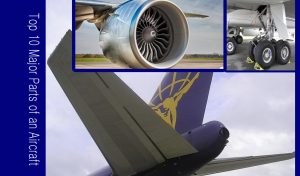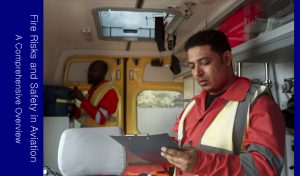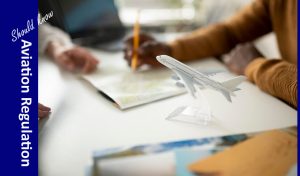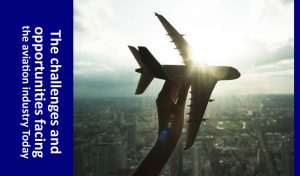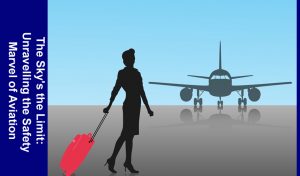The aviation industry has long been a symbol of human progress and innovation. Since the Wright brothers’ first flight in 1903, air travel has revolutionized transportation, connecting people and places across the globe. The challenges and opportunities facing the aviation industry today is very wide.
However, the industry is not without its challenges. In recent years, the aviation industry has faced a number of headwinds, including rising fuel costs, increased competition, and environmental concerns. Despite these challenges, there are also a number of opportunities for the industry to grow and thrive. In this article, we will explore some of the key challenges and opportunities facing the aviation industry.
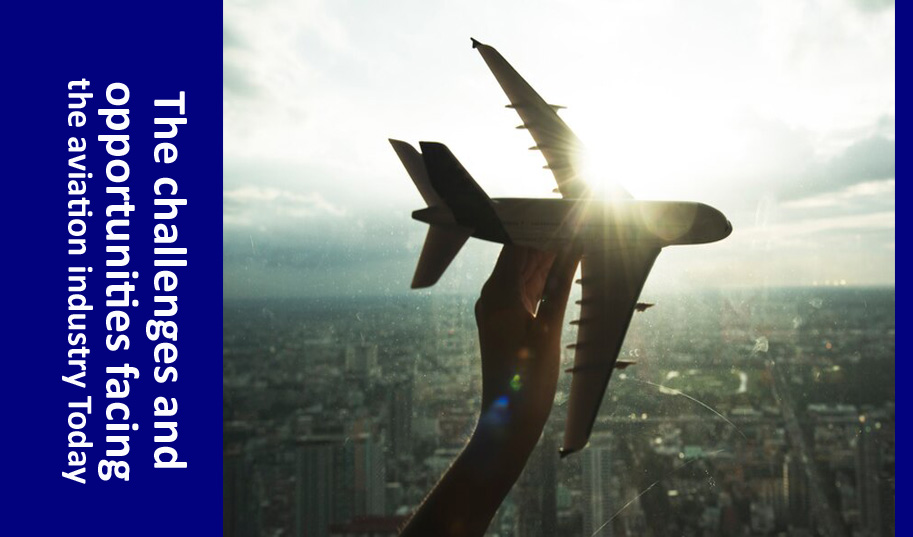
Challenges
Rising fuel costs:
Rising fuel costs are a major challenge facing the aviation industry. Fuel is one of the largest operating costs for airlines, accounting for up to 50% of their total expenses. As fuel prices rise, airlines are forced to either pass on the costs to customers in the form of higher fares or reduce their profit margins.
In 2022, the price of jet fuel soared to its highest level in over a decade, driven by factors such as the war in Ukraine and increased demand from recovering economies. This has put a significant strain on airlines, many of which are still struggling to recover from the pandemic.
To cope with rising fuel costs, airlines are implementing several strategies, including:
- Increasing fares: Airlines are passing on some of the higher fuel costs to customers in the form of higher fares. In 2022, average fares for domestic flights in the United States rose by 12%.
- Reducing capacity: Airlines are reducing the number of flights they operate in order to save fuel. This has led to some routes being cut and fewer flights being offered on popular routes.
- Hedging fuel prices: Airlines are using hedging strategies to try to lock in lower fuel prices. This involves purchasing options contracts that give them the right to buy fuel at a certain price in the future.
- Improving fuel efficiency: Airlines are investing in new aircraft and technologies that are more fuel-efficient. This includes lighter aircraft, more aerodynamic designs, and more efficient engines.
Despite these efforts, rising fuel costs are likely to continue to be a challenge for the aviation industry in the years to come. The International Air Transport Association (IATA) forecasts that fuel costs will account for 40% of airlines’ total expenses in 2023.
Increased competition:
Increased competition is another major challenge facing the aviation industry. The industry has become increasingly fragmented in recent years, with the rise of low-cost carriers and the entry of new airlines from emerging markets. This has led to a decrease in fares and an increase in capacity, which has put pressure on profits for many airlines.
Increased competition is another major challenge facing the aviation industry. The industry has become increasingly fragmented in recent years, with the rise of low-cost carriers and the entry of new airlines from emerging markets. This has led to a decrease in fares and an increase in capacity, which has put pressure on profits for many airlines.
Here are some of the specific challenges that increased competition is posing for the aviation industry:
- Price pressure: Airlines are facing intense price pressure from low-cost carriers, which are typically able to operate at lower costs. This is making it difficult for airlines to differentiate themselves and maintain their market share.
- Overcapacity: The aviation industry is facing overcapacity, as airlines have added too much capacity to meet demand. This is leading to lower fares and reduced profitability for many airlines.
- Consolidation: Airlines are consolidating in an effort to reduce costs and gain market share. However, consolidation can also lead to higher fares and less competition.
Here are some examples of how airlines are differentiating themselves in the competitive aviation industry:
- Emirates: Emirates is known for its luxurious cabins, high-quality service, and extensive route network.
- Singapore Airlines: Singapore Airlines is known for its comfortable cabins, attentive service, and focus on innovation.
- Qatar Airways: Qatar Airways is known for its modern fleet, spacious cabins, and commitment to customer service.
Environmental concerns:
Environmental concerns are a significant challenge facing the aviation industry. The industry is a major contributor to climate change, air pollution, and noise pollution.
Climate change:
Aviation is responsible for about 2.5% of global greenhouse gas emissions. This is due to the combustion of jet fuel, which releases carbon dioxide (CO2) and other greenhouse gases into the atmosphere. CO2 is a major contributor to climate change, and the aviation industry is one of the fastest-growing sectors of the global economy.
Air pollution:
Aircraft engines emit a variety of pollutants, including nitrogen oxides (NOx), sulfur oxides (SOx), particulate matter (PM), and hydrocarbons. These pollutants can cause a variety of health problems, including respiratory problems, heart disease, and cancer. They can also contribute to acid rain and smog.
Noise pollution:
Aircraft noise can be a major nuisance for people living near airports and flight paths. It can also disrupt wildlife and interfere with sensitive activities, such as sleep and learning.
The aviation industry is taking a number of steps to address these environmental concerns. These steps include:
- Developing more fuel-efficient aircraft: Airlines are working with aircraft manufacturers to develop more fuel-efficient aircraft. This will reduce the amount of CO2 and other greenhouse gases emitted by aircraft.
- Using sustainable aviation fuels (SAFs): SAFs are fuels that are made from renewable sources, such as plant oils or waste biomass. SAFs can reduce the lifecycle CO2 emissions of aviation by up to 80%.
- Improving air traffic management (ATM): ATM is the system that controls the flow of air traffic. Improved ATM can reduce the amount of time that aircraft spend idling on the ground and in the air, which can reduce fuel consumption and emissions.
- Operating more efficient airports: Airports can reduce their environmental impact by using renewable energy, implementing energy-saving measures, and reducing waste.
Labor shortages:
Labor shortages are a major challenge facing the aviation industry. The industry is facing a shortage of pilots, mechanics, air traffic controllers, and other skilled workers. This shortage is due to a number of factors, including:
- An aging workforce: Many of the industry’s current workers are reaching retirement age. This is creating a wave of retirements that is outpacing the number of new workers entering the industry.
- A lack of qualified workers: The aviation industry requires a high level of skill and training. There is a shortage of qualified workers who have the skills and training needed to fill these jobs.
- Low pay and benefits: The aviation industry is known for its low pay and benefits. This makes it difficult to attract and retain qualified workers.
The aviation industry is taking a number of steps to address the labor shortage. These steps include:
- Increasing training and education: The industry is increasing the amount of training and education available to potential workers. This is helping to develop the pipeline of qualified workers.
- Promoting careers in aviation: The industry is promoting careers in aviation to young people and women. This is helping to increase awareness of the industry and the opportunities available.
- Improving pay and benefits: Airlines are improving pay and benefits in order to attract and retain qualified workers. This is making the industry more competitive with other industries.
Geopolitical instability
Geopolitical instability is a significant challenge facing the aviation industry. The industry is highly reliant on stable international relations in order to operate safely and efficiently. When political tensions rise, it can lead to a number of disruptions to the aviation industry, including:
- Closed airspace: Countries may close their airspace to aircraft from countries they are in conflict with. This can disrupt flight paths and lead to cancellations and delays.
- Travel restrictions: Countries may impose travel restrictions on citizens of countries they are in conflict with. This can make it difficult or impossible for people to travel to or from those countries.
- Increased security risks: Political tensions can increase the risk of terrorism and other security threats. This can lead to increased security measures at airports and other aviation facilities.
Geopolitical instability can have a significant impact on the aviation industry. It can lead to lost revenue, increased costs, and reputational damage. In some cases, it can even lead to the collapse of airlines.
The aviation industry is taking a number of steps to mitigate the risks of geopolitical instability. These steps include:
- Diversifying routes: Airlines are diversifying their routes to avoid being reliant on airspace that may be closed.
- Increasing security measures: Airlines are increasing security measures to protect against terrorism and other security threats.
- Lobbying for government support: Airlines are lobbying governments for support to help them mitigate the risks of geopolitical instability.
Cybersecurity threats:
The aviation industry is increasingly reliant on digital technologies, which has made it a prime target for cyberattacks. These attacks can have a significant impact on the industry, including:
- Disruptions to operations: Cyberattacks can disrupt flight operations by targeting air traffic control systems, reservation systems, and other critical infrastructure. This can lead to delays, cancellations, and even accidents.
- Data breaches: Cyberattacks can also lead to data breaches, which can expose sensitive information about passengers, employees, and airlines. This can lead to identity theft, financial fraud, and reputational damage.
- Ransomware attacks: Ransomware is a type of malware that encrypts files and demands a ransom payment in exchange for the decryption key. Ransomware attacks can cripple an airline’s operations and cause significant financial losses.
Opportunities
Growth in air travel:
The growth in air travel is creating a number of opportunities for the aviation industry. These opportunities include:
- Increased demand for aircraft: As more people travel by air, there will be an increased demand for new aircraft. This is a major opportunity for aircraft manufacturers, such as Boeing and Airbus.
- Increased demand for maintenance and repair services: As aircraft are used more, they will require more maintenance and repair. This is a major opportunity for companies that provide maintenance and repair services, such as MROs (maintenance, repair, and overhaul) providers.
- Increased demand for airport services: As more people travel through airports, there will be an increased demand for airport services, such as catering, ground handling, and security. This is a major opportunity for companies that provide these services, such as Sodexo and Menzies Aviation.
- Increased demand for air cargo services: As more goods are transported by air, there will be an increased demand for air cargo services. This is a major opportunity for airlines and air cargo carriers, such as FedEx and UPS.
- Increased demand for aviation tourism: Aviation tourism is a growing industry that involves people traveling to experience aviation, such as visiting air shows or taking flying lessons. This is a major opportunity for tourism destinations and businesses that provide aviation-related experiences.
The aviation industry is expected to continue to grow in the coming years. The International Air Transport Association (IATA) forecasts that passenger traffic will grow by 4.3% in 2023, and that air cargo traffic will grow by 3.8%. This growth is being driven by a number of factors, including increasing demand from developing economies and the continued growth of e-commerce.
Here are some examples of how companies are capitalizing on the growth in air travel:
- Boeing: Boeing is developing new fuel-efficient aircraft, such as the 787 Dreamliner and the 737 MAX.
- Airbus: Airbus is investing in the development of sustainable aviation fuels (SAFs).
- Sodexo: Sodexo is providing catering and other services to airports around the world.
- Menzies Aviation: Menzies Aviation is providing ground handling services to airlines around the world.
- Emirates: Emirates is investing in the development of new routes and services to meet the growing demand from passengers in developing economies.
Technological innovation:
Technological innovation is creating a number of opportunities for the aviation industry. These opportunities include:
- More fuel-efficient aircraft: Airlines are investing in new aircraft that are more fuel-efficient. This will help to reduce fuel costs and emissions, which will benefit airlines and the environment.
- Sustainable aviation fuels (SAFs): SAFs are fuels that are made from renewable sources, such as plant oils or waste biomass. SAFs can reduce the lifecycle CO2 emissions of aviation by up to 80%. Airlines are investing in the development and use of SAFs.
- Advanced air traffic management (ATM) systems: ATM systems are used to control the flow of air traffic. Advanced ATM systems can help to reduce congestion and delays, which will benefit airlines and passengers.
- Data analytics: Airlines are using data analytics to improve their operations and customer service. For example, airlines are using data analytics to optimize flight schedules, predict maintenance needs, and personalize customer offers.
- Artificial intelligence (AI): AI is being used to develop a number of new applications in the aviation industry, such as autonomous aircraft, predictive maintenance, and chatbots.
- Virtual and augmented reality (VR and AR): VR and AR are being used to train pilots and mechanics, and to develop new customer experiences.
- Internet of Things (IoT): The IoT is being used to collect data from aircraft and airports, which can be used to improve efficiency and safety.
- Robotics: Robots are being used to automate tasks at airports, such as baggage handling and security screening.
Here are some examples of how technological innovation is transforming the aviation industry:
- Emirates: Emirates is using data analytics to optimize its flight schedules and predict maintenance needs.
- Qatar Airways: Qatar Airways is using AI to develop autonomous aircraft.
- Singapore Airlines: Singapore Airlines is using VR to train its pilots.
- Airbus: Airbus is using the IoT to collect data from its aircraft, which can be used to improve efficiency.
- Boeing: Boeing is using robotics to automate tasks at its factories.
Evolving customer preferences:
The aviation industry is constantly evolving to meet the changing needs and preferences of customers. Some of the key trends in customer preferences that are shaping the industry include:
- A desire for personalized experiences: Customers are increasingly expecting personalized experiences from airlines and airports. This includes things like personalized flight recommendations, customized meal options, and priority access to security lanes.
- A focus on sustainability: Customers are increasingly concerned about the environmental impact of aviation. Airlines are responding by investing in sustainable aviation fuels (SAFs), developing more fuel-efficient aircraft, and implementing carbon offset programs.
- A demand for connectivity: Customers are increasingly expecting to be connected throughout their travel journey. This includes things like in-flight Wi-Fi, mobile boarding passes, and real-time flight updates.
- A preference for convenience: Customers are increasingly looking for ways to make their travel experience more convenient. This includes things like self-service check-in kiosks, mobile payment options, and baggage tracking services.
- A desire for value: Customers are increasingly looking for good value for their money. Airlines are responding by offering a wider range of fares and options, as well as bundling fares with other services, such as hotel accommodations and car rentals.
Growing demand for sustainable aviation fuel:
The growing demand for sustainable aviation fuel (SAF) is creating a number of opportunities for the aviation industry. SAF is a type of aviation fuel that is made from renewable sources, such as plant oils or waste biomass. SAFs can reduce the lifecycle CO2 emissions of aviation by up to 80%.
Here are some of the specific opportunities that the growing demand for SAF is creating for the aviation industry:
- New business opportunities: The production and sale of SAF is a new and rapidly growing industry. This is creating new business opportunities for a variety of companies, including feedstock producers, biofuel refineries, and distributors.
- Environmental benefits: SAF can significantly reduce the environmental impact of aviation. This is making airlines and other aviation stakeholders more interested in using SAF.
- Government support: Governments around the world are providing financial and regulatory support for the development and use of SAF. This is helping to accelerate the development of the SAF industry.
Here are some examples of how companies are capitalizing on the growing demand for SAF:
- Neste: Neste is a Finnish company that is a leading producer of SAF.
- Gevo: Gevo is an American company that is developing a new SAF technology.
- World Energy: World Energy is a British company that is investing in SAF production.
- United Airlines: United Airlines is a major airline that is committed to using SAF.
- Alaska Airlines: Alaska Airlines is another major airline that is investing in SAF.
Expansion into new markets:
The expansion into new markets is a significant opportunity for the aviation industry. By entering new markets, airlines can access new customer bases, diversify their revenue streams, and reduce their reliance on any one market.
Here are some of the specific opportunities that expanding into new markets can create for airlines:
- Increased passenger traffic: Airlines can increase their passenger traffic by entering new markets with a large population and a growing middle class.
- Higher revenue: Airlines can generate higher revenue by entering new markets with high fares and high demand for air travel.
- Reduced competition: Airlines can reduce competition by entering new markets where there are few or no established airlines.
- Improved brand recognition: Airlines can improve their brand recognition by entering new markets where they are not well-known.
- Access to new resources: Airlines can gain access to new resources by entering new markets with a large pool of skilled labor or a favorable regulatory environment.
Here are some examples of how airlines are expanding into new markets:
- Emirates: Emirates has expanded its network to over 150 destinations in over 80 countries.
- Qatar Airways: Qatar Airways has expanded its network to over 100 destinations in over 70 countries.
- Singapore Airlines: Singapore Airlines has expanded its network to over 60 destinations in over 30 countries.
- Delta Air Lines: Delta Air Lines has expanded its network to over 330 destinations in over 50 countries.
- United Airlines: United Airlines has expanded its network to over 260 destinations in over 60 countries.
Overall, expanding into new markets is a significant opportunity for the aviation industry. Airlines that are able to successfully enter new markets will be well-positioned for growth and success in the years to come.
Conclusion
The aviation industry is a dynamic and ever-changing industry. Airlines that are able to adapt to the challenges and opportunities ahead will be well-positioned for success in the years to come.
FAQs
- What is the biggest challenge facing the aviation industry?
Rising fuel costs are one of the biggest challenges facing the aviation industry.
- What are some of the opportunities facing the aviation industry?
There are a number of opportunities facing the aviation industry, including growth in air travel, technological innovation, evolving customer preferences, growing demand for sustainable aviation fuel, and expansion into new markets.
- How can airlines adapt to the changing landscape of the aviation industry?
Airlines can adapt to the changing landscape of the aviation industry by embracing new technologies, offering personalized and convenient travel experiences, adopting sustainable practices, and expanding into new markets.
- What is the future of the aviation industry?
The future of the aviation industry is bright. With continued innovation and adaptation, the aviation industry is well-positioned to continue to connect people and places across the globe for many years to come.
